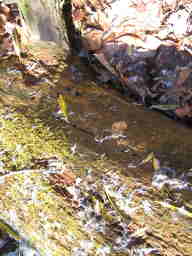![]() Observation: The First Step in the Scientific Method
Observation: The First Step in the Scientific Method
To observe means to look at something and to notice the details. When people observe things they often wonder
why it is that way. Scientists work to answer that question. They make observations as the first step
to the scientific method.
Observations are also called data. There are two kinds of data.
* Qualitative data are descriptions that do not have numbers. Scientists use their senses to make these observations.
It is too hot to play outside today. You could fry an egg on the sidewalk! No one will use the metal slide. It is too hot to touch. One girl touches it with her hand. She pulls it away immediately and shakes her hand. Several groups of children play quietly in the dense shade of the old maple and gum trees that grow at edge of the playground. This is an example of qualitative data.
* Quantitative data are obtained by measuring and have numbers. Scientists use instruments (tools) to obtain numbers based data.
8/18/08 1300 GMT - the thermometer reads 42° Celsius on the playground. The metal slide's surface is 44° Celsius.
It is important to be a careful observer. The smallest detail may be important to finding the answer to a question.
Practice observing by looking at this photo. How many details you can find?
If you click here, a closer view will appear. Use the Back Button of your browser to return to this web page.
1. Write your observations - Make as many observations as you can.
Collect at least 2 quantitative data and 2 qualitative data.
2. Imagine - If you were standing in the scene:
What tools (instruments) would help you to be a better observer?
3.
How would a table help organize the data that is being collected?
4. Your next step, in explaining this evidence, would be to do some research.
What resources would help you explain what the photo shows?
Explore further:
About Units of Measurement - IB Biology | Observing Biology how to's
Steps of the Scientific Method - Science Buddies | Student Observation Network@ NASA
Learn about the Scientific Method Activity | Winter science mystery
Observation Skills Builders index
"We value our sight above almost everything else. The reason for this is that of all the senses sight
makes knowledge most possible for us and shows us the many differences between things." Aristotle, "Metaphysics"
Fields Meadows & Fencerows EcoStudy Unit | Wetlands EcoStudy Unit
Collecting Data | Bluebirds Project | Nests Internet Hunt | Eggs Facts Finds: Begin - Adv. | Birds Basics | Adv Birds Activity
![]()
All trademarks, copyright and logos belong to their respective owners.
Internet Hunts / Nature / Water & Watersheds / Computers / Famous Pennsylvanians / Civics / Puzzles & Projects / Site map / Home
Posted
by Cynthia J. O'Hora 3/2009
Aligned
with Pennsylvania Academic Standards | Assessment and Rubrics
![]() Save a tree - use a Digital Answer Format - Highlight the text. Copy it. Paste it in a word processing document. Save the document in your folder. Answer on the word processing document. Save frequently as you work. I have never liked losing my work. You will not like it either. Be sure to enter your name & the date in the header of the document. Submit the assignment via an email attachment or class electronic dropbox. Bad things happen: Save a copy of the response document for your records.
Save a tree - use a Digital Answer Format - Highlight the text. Copy it. Paste it in a word processing document. Save the document in your folder. Answer on the word processing document. Save frequently as you work. I have never liked losing my work. You will not like it either. Be sure to enter your name & the date in the header of the document. Submit the assignment via an email attachment or class electronic dropbox. Bad things happen: Save a copy of the response document for your records.
Proof your responses. It is funny how speling errors and typeos sneak in to the betswork. ![]() Make your own printer paper answer sheet
Make your own printer paper answer sheet
